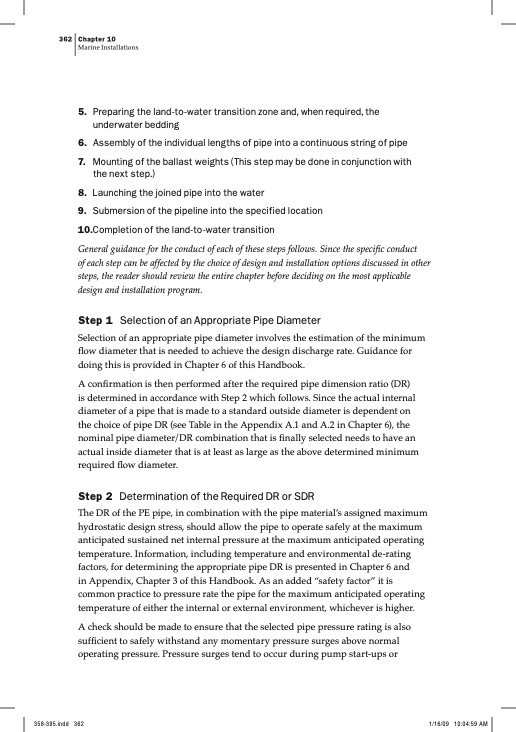
PDF Publication Title:
Text from PDF Page: 004
362 Chapter 10 Marine Installations 5. Preparing the land-to-water transition zone and, when required, the underwater bedding 6. Assembly of the individual lengths of pipe into a continuous string of pipe 7. Mounting of the ballast weights (This step may be done in conjunction with the next step.) 8. Launching the joined pipe into the water 9. Submersion of the pipeline into the specified location 10.Completion of the land-to-water transition General guidance for the conduct of each of these steps follows. Since the specific conduct of each step can be affected by the choice of design and installation options discussed in other steps, the reader should review the entire chapter before deciding on the most applicable design and installation program. Step 1 Selection of an Appropriate Pipe Diameter Selection of an appropriate pipe diameter involves the estimation of the minimum flow diameter that is needed to achieve the design discharge rate. Guidance for doing this is provided in Chapter 6 of this Handbook. A confirmation is then performed after the required pipe dimension ratio (DR) is determined in accordance with Step 2 which follows. Since the actual internal diameter of a pipe that is made to a standard outside diameter is dependent on the choice of pipe DR (see Table in the Appendix A.1 and A.2 in Chapter 6), the nominal pipe diameter/DR combination that is finally selected needs to have an actual inside diameter that is at least as large as the above determined minimum required flow diameter. Step 2 Determination of the Required DR or SDR The DR of the PE pipe, in combination with the pipe material’s assigned maximum hydrostatic design stress, should allow the pipe to operate safely at the maximum anticipated sustained net internal pressure at the maximum anticipated operating temperature. Information, including temperature and environmental de-rating factors, for determining the appropriate pipe DR is presented in Chapter 6 and in Appendix, Chapter 3 of this Handbook. As an added “safety factor” it is common practice to pressure rate the pipe for the maximum anticipated operating temperature of either the internal or external environment, whichever is higher. A check should be made to ensure that the selected pipe pressure rating is also sufficient to safely withstand any momentary pressure surges above normal operating pressure. Pressure surges tend to occur during pump start-ups orPDF Image | Marine Installations PE

PDF Search Title:
Marine Installations PEOriginal File Name Searched:
PE-Marine-Installations.pdfDIY PDF Search: Google It | Yahoo | Bing
Development of a solar powered Electric Ship The Electricship website originally started off as a project to develop a comprehensive renewable, affordable, modular electric ship... More Info
Modular Boat Hull Composite The case for a unsinkable, modular composite hybrid boat hull... More Info
MS Burgenstock Hybrid Electric Catamaran Lake Lucerne Unique shuttle servicing Lucerne to the Burgenstock Resort... More Info
Ground Power Unit GPU Powered by Lithium Ion Batteries The goal of the Ground Power Unit is to provide a readily accessible, modular, ready-to-power solution for remote power... More Info
| CONTACT TEL: 608-238-6001 Email: greg@electricship.com | RSS | AMP |